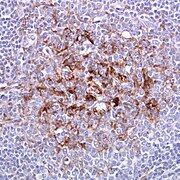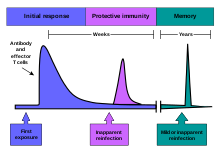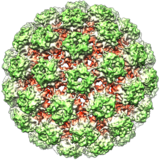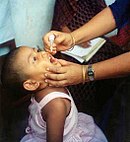Portal:Viruses
The Viruses Portal
Welcome!

Viruses are small infectious agents that can replicate only inside the living cells of an organism. Viruses infect all forms of life, including animals, plants, fungi, bacteria and archaea. They are found in almost every ecosystem on Earth and are the most abundant type of biological entity, with millions of different types, although only about 6,000 viruses have been described in detail. Some viruses cause disease in humans, and others are responsible for economically important diseases of livestock and crops.
Virus particles (known as virions) consist of genetic material, which can be either DNA or RNA, wrapped in a protein coat called the capsid; some viruses also have an outer lipid envelope. The capsid can take simple helical or icosahedral forms, or more complex structures. The average virus is about 1/100 the size of the average bacterium, and most are too small to be seen directly with an optical microscope.
The origins of viruses are unclear: some may have evolved from plasmids, others from bacteria. Viruses are sometimes considered to be a life form, because they carry genetic material, reproduce and evolve through natural selection. However they lack key characteristics (such as cell structure) that are generally considered necessary to count as life. Because they possess some but not all such qualities, viruses have been described as "organisms at the edge of life".
Selected disease
Variant Creutzfeldt–Jakob disease, or vCJD, is a rare type of central nervous system disease within the transmissible spongiform encephalopathy family, caused by a prion. First identified in 1996, vCJD is now distinguished from classic CJD. The incubation period is believed to be years, possibly over 50 years. Prion protein can be detected in appendix and lymphoid tissue (pictured) up to two years before the onset of neurological symptoms, which include psychiatric problems, behavioural changes and painful sensations. Abnormal prion proteins build up as amyloid deposits in the brain, which acquires a characteristic spongiform appearance, with many round vacuoles in the cerebellum and cerebrum. The average life expectancy after symptoms start is 13 months.
About 170 cases have been recorded in the UK, and 50 cases in the rest of the world. The estimated prevalence in the UK is about 1 in 2000, higher than the reported cases. Transmission is believed to be mainly from consuming beef contaminated with the bovine spongiform encephalopathy prion, but may potentially also occur via blood products or contaminated surgical equipment. Infection is also believed to require a specific genetic susceptibility in the PRNP-encoding gene. Human PRNP protein can have either methionine or valine at position 129; nearly all of those affected had two copies of the methionine-containing form, found in 40% of Caucasians.
Selected image
The Varroa destructor mite can transmit viruses, including deformed wing virus, to its honey bee host. This might contribute to colony collapse disorder, in which worker bees abruptly disappear.
Credit: Eric Erbe & Christopher Pooley
In the news
26 February: In the ongoing pandemic of severe acute respiratory syndrome coronavirus 2 (SARS-CoV-2), more than 110 million confirmed cases, including 2.5 million deaths, have been documented globally since the outbreak began in December 2019. WHO
18 February: Seven asymptomatic cases of avian influenza A subtype H5N8, the first documented H5N8 cases in humans, are reported in Astrakhan Oblast, Russia, after more than 100,0000 hens died on a poultry farm in December. WHO
14 February: Seven cases of Ebola virus disease are reported in Gouécké, south-east Guinea. WHO
7 February: A case of Ebola virus disease is detected in North Kivu Province of the Democratic Republic of the Congo. WHO
4 February: An outbreak of Rift Valley fever is ongoing in Kenya, with 32 human cases, including 11 deaths, since the outbreak started in November. WHO
21 November: The US Food and Drug Administration (FDA) gives emergency-use authorisation to casirivimab/imdevimab, a combination monoclonal antibody (mAb) therapy for non-hospitalised people twelve years and over with mild-to-moderate COVID-19, after granting emergency-use authorisation to the single mAb bamlanivimab earlier in the month. FDA 1, 2
18 November: The outbreak of Ebola virus disease in Équateur Province, Democratic Republic of the Congo, which started in June, has been declared over; a total of 130 cases were recorded, with 55 deaths. UN
Selected article
The immune system is a system of structures and processes within an organism that protects against disease. It must detect a wide variety of pathogens – from viruses to parasitic worms – distinguish them from the organism's own healthy tissue, and neutralise them. Simple unicellular organisms such as bacteria have enzymes that protect against bacteriophage infections. Other basic immune mechanisms, including phagocytosis, antimicrobial peptides called defensins, and the complement system, evolved in ancient eukaryotes and are found in plants and invertebrates.
Humans and most other vertebrates have more sophisticated defence mechanisms, including the ability to adapt over time to recognise specific pathogens more efficiently. Adaptive immunity creates immunological memory after an initial response to a specific pathogen, leading to an enhanced response to subsequent encounters with that same pathogen. This process of acquired immunity is the basis of vaccination. Viruses and other pathogens can rapidly evolve to evade immune detection, and some viruses, notably HIV, cause the immune system to function less effectively.
Selected outbreak
The 1976 Zaire Ebola virus outbreak was one of the first two recorded outbreaks of the disease. The causative agent was identified as a novel virus, named for the region's Ebola River. The first identified case, in August, worked in the school in Yambuku, a small rural village in Mongala District, north Zaire. He had been treated for suspected malaria at the Yambuku Mission Hospital, which is now thought to have spread the virus by giving vitamin injections with inadequately sterilised needles, particularly to women attending prenatal clinics. Unsafe burial practices also spread the virus.
The outbreak was contained by quarantining local villages, sterilising medical equipment and providing protective clothing to medical personnel, and was over by early November. A total of 318 cases was recorded, of whom 280 died, an 88% case fatality rate. An earlier outbreak in June–November in Nzara, Sudan, was initially thought to be linked, but was shown to have been caused by a different species of Ebola virus.
Selected quotation
| “ | We live in a dancing matrix of viruses; they dart, rather like bees, from organism to organism, from plant to insect to mammal to me and back again, and into the sea, tugging along pieces of this genome, strings of genes from that, transplanting grafts of DNA, passing around heredity as though at a great party. | ” |
Recommended articles
Viruses & Subviral agents: bat virome • elephant endotheliotropic herpesvirus • HIV • introduction to viruses![]() • Playa de Oro virus • poliovirus • prion • rotavirus
• Playa de Oro virus • poliovirus • prion • rotavirus![]() • virus
• virus![]()
Diseases: colony collapse disorder • common cold • croup • dengue fever![]() • gastroenteritis • Guillain–Barré syndrome • hepatitis B • hepatitis C • hepatitis E • herpes simplex • HIV/AIDS • influenza
• gastroenteritis • Guillain–Barré syndrome • hepatitis B • hepatitis C • hepatitis E • herpes simplex • HIV/AIDS • influenza![]() • meningitis
• meningitis![]() • myxomatosis • polio
• myxomatosis • polio![]() • pneumonia • shingles • smallpox
• pneumonia • shingles • smallpox
Epidemiology & Interventions: 2007 Bernard Matthews H5N1 outbreak • Coalition for Epidemic Preparedness Innovations • Disease X • 2009 flu pandemic • HIV/AIDS in Malawi • polio vaccine • Spanish flu • West African Ebola virus epidemic
Virus–Host interactions: antibody • host • immune system![]() • parasitism • RNA interference
• parasitism • RNA interference![]()
Methodology: metagenomics
Social & Media: And the Band Played On • Contagion • "Flu Season" • Frank's Cock![]() • Race Against Time: Searching for Hope in AIDS-Ravaged Africa
• Race Against Time: Searching for Hope in AIDS-Ravaged Africa![]() • social history of viruses
• social history of viruses![]() • "Steve Burdick" • "The Time Is Now" • "What Lies Below"
• "Steve Burdick" • "The Time Is Now" • "What Lies Below"
People: Brownie Mary • Macfarlane Burnet![]() • Bobbi Campbell • Aniru Conteh • people with hepatitis C
• Bobbi Campbell • Aniru Conteh • people with hepatitis C![]() • HIV-positive people
• HIV-positive people![]() • Bette Korber • Henrietta Lacks • Linda Laubenstein • Barbara McClintock
• Bette Korber • Henrietta Lacks • Linda Laubenstein • Barbara McClintock![]() • poliomyelitis survivors
• poliomyelitis survivors![]() • Joseph Sonnabend • Eli Todd • Ryan White
• Joseph Sonnabend • Eli Todd • Ryan White![]()
Selected virus
Papillomaviruses are small non-enveloped DNA viruses that make up the Papillomaviridae family. Their circular double-stranded genome is around 8000 nucleotides long. The icosahedral capsid is 55–60 nm in diameter. They infect humans, other mammals and some other vertebrates including birds, snakes, turtles and fish. Around a hundred species are classified into 53 genera. All papillomaviruses replicate exclusively in epithelial cells of stratified squamous epithelium, which forms the skin and some mucosal surfaces, including the lining of the mouth, airways, genitals and anus.
Infection by most papillomaviruses is either asymptomatic or causes small benign tumours known as warts or papillomas. Francis Peyton Rous showed in 1935 that the Shope papilloma virus could cause skin cancer in rabbits – the first time that a virus was shown to cause cancer in mammals – and papillomas caused by some virus types, including human papillomavirus 16 and 18, carry a risk of becoming cancerous if the infection persists. Papillomaviruses are associated with cancers of the cervix, vulva, vagina, penis, oropharynx and anus in humans.
Did you know?
- ...that Burchard Kranich allegedly cured Queen Elizabeth I (pictured) of smallpox?
- ...that the rabbit flea is a vector for the virus that causes myxomatosis?
- ...that when NBC pulled "Steve Burdick", an AIDS-themed episode of the medical drama Lifestories, gay and AIDS activists accused the network of fearing advertiser backlash?
- ...that in addition to infecting squashes, the squash mosaic virus also infects melons?
- ...that former GlaxoSmithKline executive Moncef Slaoui is chief adviser to Operation Warp Speed, which aims to deliver 300 million doses of a vaccine for COVID-19 by January 2021?
Selected biography
Ali Maow Maalin (1954 – 22 July 2013) was a hospital cook and health worker from Merca, Somalia, who is the last person in the world known to be infected with naturally occurring smallpox. Although he worked in the local smallpox eradication programme, he had not been successfully vaccinated. In October 1977, he was infected with the Variola minor strain of the virus while driving two children with smallpox symptoms to quarantine. He did not experience complications and made a full recovery. An aggressive containment campaign was successful in preventing an outbreak, and smallpox was declared to have been eradicated globally by the World Health Organization (WHO) two years later.
In later life, Maalin volunteered for the successful poliomyelitis eradication campaign in Somalia. He worked for WHO as a local coordinator with responsibility for social mobilisation, and spent several years travelling across Somalia, vaccinating children and educating communities. He encouraged people to be vaccinated by sharing his experiences with smallpox. He died of malaria while carrying out polio vaccinations after the reintroduction of poliovirus to the country in 2013.
In this month
May 1955: First issue of Virology; first English-language journal dedicated to virology
4 May 1984: HTLV-III, later HIV, identified as the cause of AIDS by Robert Gallo and coworkers
5 May 1939: First electron micrographs of tobacco mosaic virus taken by Helmut Ruska and coworkers
5 May 1983: Structure of influenza neuraminidase solved by Jose Varghese, Graeme Laver and Peter Colman
8 May 1980: WHO announced formally the global eradication of smallpox
11 May 1978: SV40 sequenced by Walter Fiers and coworkers
12 May 1972: Gene for bacteriophage MS2 coat protein is sequenced by Walter Fiers and coworkers, the first gene to be completely sequenced
13 May 2011: Boceprevir approved for the treatment of chronic hepatitis C virus (HCV) infection, the first direct-acting antiviral for HCV
14 May 1796: Edward Jenner inoculated James Phipps (pictured) with cowpox
15/16 May 1969: Death of Robert Rayford, the earliest confirmed case of AIDS outside Africa
18 May 1998: First World AIDS Vaccine Day
20 May 1983: Isolation of the retrovirus LAV, later HIV, by Luc Montagnier, Françoise Barré-Sinoussi and coworkers
23 May 2011: Telaprevir approved for the treatment of chronic HCV infection
25 May 2011: WHO declared rinderpest eradicated
31 May 1937: First results in humans from the 17D vaccine for yellow fever published by Max Theiler and Hugh H. Smith
Selected intervention
Two polio vaccines are used against the paralytic disease polio. The first, developed by Jonas Salk, consists of inactivated poliovirus. Based on three wild virulent strains, inactivated using formalin, it is administered by injection and is very safe. It confers IgG-mediated immunity, which prevents poliovirus from entering the bloodstream and protects the motor neurons, eliminating the risk of bulbar polio and post-polio syndrome. The second, developed by Albert Sabin, originally consisted of three live virus strains, attenuated by growth in cell culture. Since 2016, only two strains have generally been included. They contain multiple mutations, preventing them from replicating in the nervous system. The Sabin vaccine stimulates both antibodies and cell-mediated immunity, providing longer-lasting immunity than the Salk vaccine. It can be administered orally, making it more suitable for mass vaccination campaigns. In around three cases per million doses, the live vaccine reverts to a virulent form and causes paralysis. Vaccination has reduced the number of wild-type polio cases from around 350,000 in 1988 to just 33 in 2018, and eradicated the disease from most countries.
Subcategories
Subcategories of virology:
Topics
Things to do
- Comment on what you like and dislike about this portal
- Join the Viruses WikiProject
- Tag articles on viruses and virology with the project banner by adding {{WikiProject Viruses}} to the talk page
- Assess unassessed articles against the project standards
- Create requested pages: red-linked viruses | red-linked virus genera
- Expand a virus stub into a full article, adding images, citations, references and taxoboxes, following the project guidelines
- Create a new article (or expand an old one 5-fold) and nominate it for the main page Did You Know? section
- Improve a B-class article and nominate it for Good Article
 or Featured Article
or Featured Article status
status - Suggest articles, pictures, interesting facts, events and news to be featured here on the portal
WikiProjects & Portals
 WikiProject Viruses
Related WikiProjects
WikiProject Viruses
Related WikiProjects
Medicine • Microbiology • Molecular & Cellular Biology • Veterinary Medicine
Related PortalsAssociated Wikimedia
The following Wikimedia Foundation sister projects provide more on this subject:
-
Commons
Free media repository -
Wikibooks
Free textbooks and manuals -
Wikidata
Free knowledge base -
Wikinews
Free-content news -
Wikiquote
Collection of quotations -
Wikisource
Free-content library -
Wikispecies
Directory of species -
Wikiversity
Free learning tools -
Wiktionary
Dictionary and thesaurus


















